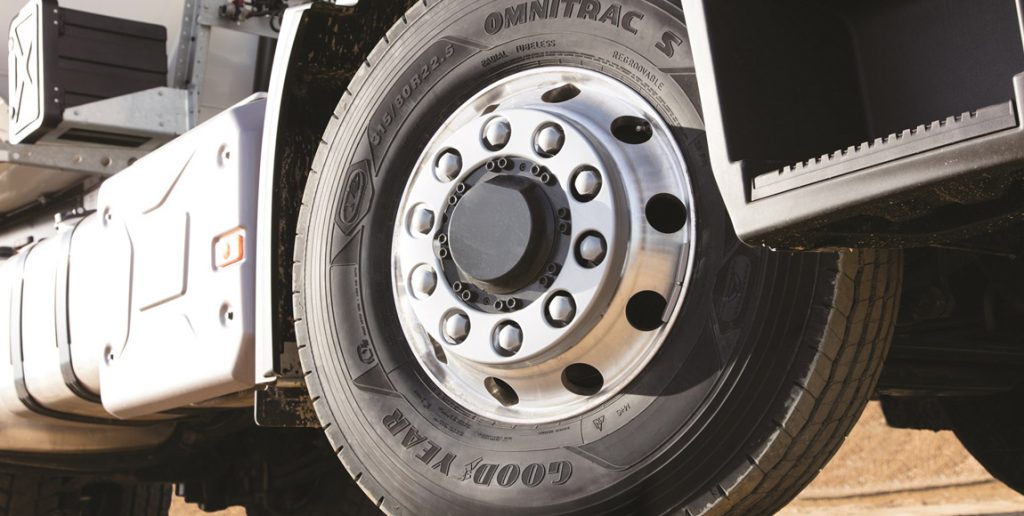Tyres – back to basics

For a truck tyre, the only contact with the ground is a contact surface area equal to three hands, or an A4 piece of paper. It’s therefore important to ensure they are fit for purpose
Tyres have an influence on braking, acceleration, cornering, handling, as well as mechanical and acoustic comfort. Tyres also contribute significantly to the overall operating costs in the transport industry. In addition, tyres can be optimised to improve fuel efficiency, durability and endurance.
Modern tyres share two significant innovations: most are tubeless and almost all are “radial”. The term radial refers to the construction of the tyre and the placement of cord plies at 90° to the direction of travel (or radially from the centre of the tyre). Michelin is credited with creating, or at least commercialising, the manufacture of radial car tyres in 1946 (1952 for trucks).
On the other hand, Continental has been credited with creating the world’s first tubeless tyre. Both of these advances in tyre design resulted in massive improvements in fuel efficiency, durability and endurance.
Application
Certain industries, such as construction, waste management, mining, forestry and agriculture, require transporters to make collection and delivery on site in remote locations. Others operators may work in urban areas where curb rash destroys side walls or may travel national routes where there is potential for heat build-up in tyre casings.
Despite progress in producing tyres suitable for a wide range of applications, tyre designers must still balance the sometimes opposing characteristics of safety, longevity and performance.
Continental states that selecting the correct tyre is more important than ever. “As with all transport solutions, it’s all about cost efficiency and customised solutions. Not all roads are the same, nor are truck tyres, and this is why we have product lines for goods, people and construction,” asserts the company.
There are also tyres designed for off-road, on-road, or mixed-service use, different weather conditions as well as urban, regional and national routes.
Tyre components
There are a few basic components, or parts that go into the construction of a tyre. Manufacturers experiment with the different materials or designs to instil particular characteristics into a tyre that make it suitable for specific applications.
• The tread strip is the specialised rubber compound that makes contact with the road, and its optimisation leads to improvements in grip and rolling resistance.
• Beneath this are the multi-ply steel belts that consist of steel cords that are embedded in the rubber compound beneath the tread strip. These steel belts help improve driving stability, reduce rolling resistance and extend service life while adding structural integrity.
• Underneath the multi-ply is the steel casing, also made from steel cord. This further improves structural strength and deflection characteristics, substantially enhancing driving comfort.
• The inner liner is the innermost surface made from an impermeable rubber compound that prevents the diffusion of air and moisture in tubeless tyres.
• The sidewall is also made from a rubber compound and protects the tyre from lateral scrubbing and the effects of the weather.
• The bead is the portion of the tyre that makes contact with the rim and ensures the correct seating of the tyre with the rim. The bead reinforcement is a nylon, aramide-coated, steel cord which secures the ends of the steel cord plies within the tyre to the bead core, reinforcing it against high shear forces.
• Finally, the bead core consists of a steel wire embedded in a rubber compound.
Important markings
• Size designation indicating the tyre width in millimetres (mm), the aspect ratio, as a percentage of the height to width, and the diameter of the rim in inches.
• Service description consisting of the load index, for single and duel application and a code indicating the speed rating.
• United States load designation offering inflation values for single or duel fitment.
• Tread wear indicator (TWI) found on the circumference of the sidewall shows the point at which a tyre should be replaced or re-treaded.
• Recommended application whether it be truck or bus, regional or national use.
• Retreadable tyres offer operators the opportunity to extend the service life of marked tyres.
• Manufacturer code indicating the week and year when the tyre was produced.
• Important information about suitable application supplied after the Tubeless Radial designation, (M-S) for example, and when translated “mud and snow”.

Maintenance
According to Continental, proper tyre maintenance is the only way to ensure a tyre performs as expected. “This includes regular checking of tyre pressure and conducting external inspection of the tyres (including the inner and outer sidewalls between duel tyres).
Tyre damage must be identified immediately and rectified by authorised workshops with well-trained personnel. Continental explains that any damage to the reinforcing materials underneath the tread presents a major threat to tyre integrity and safety.
Damage as a result of a nail puncture or a deep cut is particularly dangerous, because it allows dirt and moisture to penetrate the tyre. “If this situation goes undetected the internal components will begin to rust, which creates the potential to render the tyre unusable or irreparable,” states Continental.
Goodyear recommends that fleets combine the use of high-quality tyres with the right service and solutions.
Technology
Nikolai Setzer, member of the Continental executive board and head of the Tyre division in Germany, says: “In critical situations, it is the tyre’s level of technology that is the deciding factor in whether or not a vehicle brakes in time.”
In other instances the technology imbued in a tyre may prevent a puncture, enable a tyre to be used for longer or dictate whether or not a puncture goes unnoticed. As such, manufacturers are in a race to provide products that offer something more than the competition.
For instance, Goodyear’s new Omnitrac mixed-service truck tyres are equipped with the brand’s DuraShield technology, which features an exclusive non-metallic top belt, offering extra resistance to casing damage, enhanced performance and improved retredability thanks to reduced risk of damage to the internal plies.
Also, with tyre monitoring becoming somewhat of a science, a further feature of the range is the integration of radio-frequency identification (RFID) tags. These allow simple identification and connectivity to tyre management and tracking systems.
As a final example, correct inflation of tyres is arguably the most important aspect of ensuring tyre safety, longevity and maintenance. With this in mind, Continental released ContiPressureCheck (CPC). This allows for the real-time monitoring of tyre performance, pressure and temperature and can be integrated with the fleet’s telematics provider.
Selecting the correct tyres and maintaining them correctly is likely to have a positive effect on the bottom line. Fortunately, transporters have been given a wide range of tyres to choose from, each offering its own benefits. Ultimately, it isn’t as much about brands as it is about selecting the most suitable tyre solution for a particular vehicle and application.
Published by
Focus on Transport
focusmagsa




